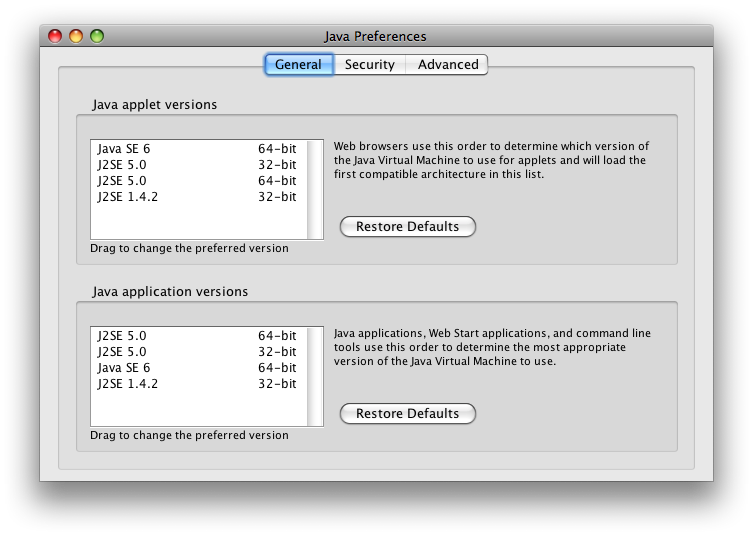The following are the system requirements for installing the JDK and the JRE on macOS:
Any Intel-based computer running macOS.
Administrator privileges.
You cannot install Java for a single user. Installing the JDK and JRE on macOS is performed on a systemwide basis for all users. Administrator privileges are required to install the JDK and JRE on macOS.
When you install the JDK, it also installs the JRE. However, the system will not replace the current JRE with a lower version.
To determine the current JRE version installed on your system, see Determining the JRE Version Installed on macOS. To install an earlier version of the JRE, you must first uninstall the current version. See Uninstalling the JRE on macOS.
When you install the JRE, you can install only one JRE on your system at a time. The system will not install a JRE that has an earlier version than the current version.
To determine the current JRE version installed on your system, see Determining the JRE Version Installed on macOS. To install an earlier version of the JRE, you must first uninstall the current version. See Uninstalling the JRE on macOS.
Note:
Installing a JRE from Oracle will not update
java -versionsymlinks or addjavato your path. To do this, you must install the JDK.
Java is a general-purpose, secure, robust, object-oriented language developed by Sun Microsystems in 1990. Java is portable which means it follows to write once run anywhere paradigm. Many of the useful application are build on Java and required Java runtime environment. If you are preparing your system for the developing new java applications, you need to install JDK on your machine.
Java for OS X installs Apple's version of Java on Macs running OS X 10.8.3 or above so that you can run Java based apps and programs on your Mac. There are also earlier versions of the software for OS. After installing Java for macOS 2012-006, can I continue to use Apple's Java 6 alongside the macOS JDK for Java 13? If you want to continue to develop with Java 6 using command-line, then you can modify the startup script for your favorite command environment. This update will correct issues affecting some Java users following the installation of Mac OS X v10.3.9 Software Update. After updating to Mac OS X 10.3.9, some systems may have issues with Java. How to install Java JDK (Java Development kit 12) on Mac OS. Download and install Java on Mac OS X. We will also update the JAVAHOME environment variable ne.
Java Download
The latest version is Java 14 which was released in March 2020. This tutorial helps you to install Java 14 latest version or Java 11 LTS on macOS Sierra or High Sierra.
Step 1 – Prerequisites
Before starting the installation of Java using this tutorial you must have the following prerequisites
- Terminal: You must have Mac Terminal access and little knowledge about working with the terminal application. Ao login to your Mac system and open terminal
- Homebrew: This tutorial relies on Homebrew, So you must have homebrew installed. Homebrew can be installed with a single command.
For more instruction visit Homebrew installation tutorial.
Step 2 – Install Homebrew Cask
On Mac systems, Homebrew is the package manager, and Homebrew Cask is the app manager built on top of Homebrew. You Execute command to update brew cache and tap the caskroom/cask.


Step 3 – Install JAVA with Homebrew Cask
Install Java 8 Mac Os X

At the time of writing this tutorial the available version, Java 11 LTS and Java 14 latest for the installation.
Brew Install Java
- Check Available Versions – Use the following commands to view the details about java versions to be install.
- Installing Java – Next, install the Java version of your choice using one of the below commands. You can also install both versions if required.
The installation process may take some time to complete depending on your network speed.
- Check Version – Once the installation finished, verify the installed Java version.
All done. You have successfully installed Java on your macOS system.
Conclusion
In this tutorial, you have learned to install Java on macOS systems using homebrew.
